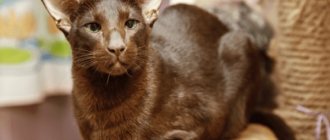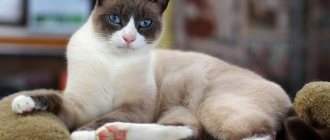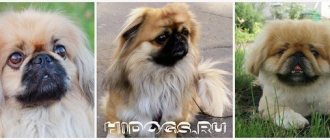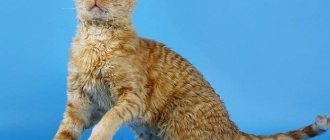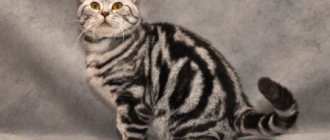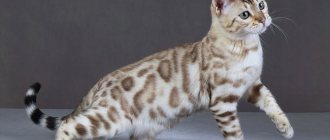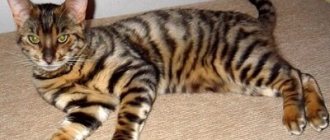It is unlikely that anyone will remain indifferent to this beauty, even people who do not have tender feelings for furry purrs. In addition to their charming appearance, Persian cats have a soft and friendly character. This animal is exceptional in all respects: the history of its origin leaves many mysteries for specialists, the breed has more than a hundred colors, but most importantly, today three standards of this breed are recognized. In this article we offer you a description that is a summary treatment of the FIFe, CFA and WCF standards.
Persian cat: history, breed description, character
This is one of the oldest breeds of domestic cats in the world. Since the 16th-17th centuries, when these animals appeared in Europe, their history can be traced quite clearly, but before this period it was full of mysteries. Today there are several versions of the appearance of these animals in European countries. According to one of them, the Italian traveler Pietro Della Valle brought them from Persia (Iran) at the beginning of the 16th century.
Another version suggests that the first long-haired cats came to France from Ankara (Turkey) in the 17th century. Everyone who is inclined to the second version is sure that the name of these animals is not connected with their place of origin, but with a certain mystery and attractiveness. In those distant times, Europe was just discovering the attractiveness of the East.
In fact, Persians have a lot in common with Angora cats. First of all, this is the structure of the body. Both breeds have well-developed shoulders and chest, a fairly strong lower back and strong muscular legs. In addition, both representatives of the breeds have a well-defined fur collar, and tufts of hair in the interdigital spaces and ears. The character of Persian cats is in many ways similar to that of their Angora relatives.
And at the same time, none of these versions answer an important question: how could animals with such long and thick hair appear in hot countries located in the Middle East? And in this case, the versions differ. Some researchers claim that long hair is the result of a mutation. This opinion has a right to exist, because it is known that many modern breeds arose precisely due to mutation. This applies to fold-eared cats, rexes, and hairless sphinxes.
Another version suggests that the ancestors of Persian cats came to eastern countries from Siberia. At first glance, this statement seems completely absurd. However, it has some justification. After all, Siberian cats were originally wild and during the course of evolution crossed with many steppe individuals. Their distinctive feature was the tufts of fluffy fur between their toes, which is known to be characteristic of Persians.
But whatever the origin of these adorable creatures, they were able to very quickly win the hearts of animal lovers in Europe. Traveling traders, wanting to increase the value of live goods in the eyes of buyers, claimed that these beauties were the result of crossing Pallas cats and sand cats.
Persian cats have another official homeland. The description of the breed, which can be read in many reference books, confirms that in the 19th century, British breeders were closely involved in long-haired cats. They divided them into Persian and Angora. Only then did they for some reason decide that Persian cats should only be blue.
In parallel with British breeders, the Germans also worked, crossing representatives of the Angora breed with other long-haired animals.
[edit] Origin
According to one common version, Persian cats were taken from Persia in the 17th century by European travelers. Over the next centuries, they served as decoration for the royal palaces of England, France and Italy.
The first country where they settled was France. From there the breed migrated to other countries of Western Europe and was called French.
The Natural History Museum in London displays engravings and photographs of Persian cats.
An Angora/Persian from "The Royal Natural History" (1894) Blue Persian. Prize-winner at Westminster in 1899 Silver Persian. Winner of multiple leading cat shows
There is also a version that the ancestor of Persian cats is the wild manul cat (due to its similar appearance, as well as its calm, slow nature), living in mountainous Asian regions.
Manul
But, after representatives of the breed came to England, where felinology was already flourishing, the breed was divided into two.
Cats with a more graceful physique and elongated muzzle were called Turkish Angora, and more massive and large-headed short cats began to be called Persian.
Its official status is the Persian Longhair
received in 1887, becoming one of the first cat breeds registered in Great Britain.
Persian cat in Russia
These animals came to our country after the end of the Cold War. They were brought by diplomats in the late eighties from business trips. At that time, Persian cats were considered very rare. The description of the breed and the character of the animals attracted the attention of Russian breeders. True, they liked not extreme cats more, but a more refined type of cat, with a softer and more classic profile.
External features
You may have heard that the Persian breed is sometimes called a baby-faced cat. This is probably not a coincidence. A special feature of the breed is its small but wide and snub nose. Depending on its shape, several varieties are distinguished. Animals with a very snub nose, reminiscent of a Pekingese, are called extreme sports. If the nose is elongated and slightly upturned, then we can talk about the classic type of breed. Cats with huge eyes, whose nose is at the level of the lower eyelid, belong to the modern type of animals.
The Persian cat of all varieties has:
- volumetric chest;
- strong and muscular legs;
- quite wide back;
- wide and large head;
- small rounded ears;
- strong neck;
- short ponytail;
- expressive and large eyes.
Coat
Magnificent wool is the pride of these animals. At the same time, it is she who makes caring for a Persian cat much more difficult. Many experts claim that Persians are the only representatives of long-haired animals. All other breeds should be classified as medium or short-haired.
The Persian's fur reaches a length of 20 cm. Its structure is silky and thin, and feels like fluff to the touch. Oddly enough, Persian fur does not play its main role. The fact is that some varieties do not even have an undercoat, and therefore such wool will not warm you outside in winter.
Persian health
All living beings have a tendency to some kind of disease. And this wonderful breed is also susceptible to certain diseases, including polycystic kidney disease. This disease sometimes leads to kidney failure in the cat's advanced age and old age. In order not to miss the first symptoms, you need to monitor the health of your older pet and if you suspect any abnormalities, immediately contact a veterinarian. It makes sense to monitor the heart condition of your breed pet, as sometimes they develop cardiomyopathy. Since the breed is classified as large, it is prone to hip dysplasia.
Timely vaccinations will protect your dog from many health problems. Vaccination of the breed is carried out according to the schedule established by the veterinarian.
After mating, the cat becomes pregnant; the gestation period depends on the number of babies in the belly. Childbirth occurs in 63-66 days. If you do not want offspring from your pet, it needs to be castrated or sterilized at the age of 9-12 months.
Eye care for Persian cats
global $ads_google;
//data-ad-slot=”2475549904″ $ads_google = empty($ads_google) ? false : true; ?> if ($ads_google == false) {?> $ads_google = true; ?> } ?> Most often, owners are worried that the Persian cat’s eyes are watery . Due to the physiology of the structure of the muzzle in this breed, the tear streams are practically blocked, which makes the charming cat a chronic crybaby. If you eliminate this cosmetic defect every day by washing your eyes with a soft, clean cloth, this will eliminate traces of “tears” on the face and make life easier for your pet. It is impossible to treat the problem anyhow, as constant discharge will thin the hair around the eyes, and it will begin to come out.
You can alternate washing your eyes with warm water and treating the area around the eyes with a mixture of boric acid, hydrogen peroxide and starch. Sometimes, even with proper care, brown discharge flows from the cat’s eyes, or the eyes begin to fester: in these cases, do not postpone a visit to a specialist.
How long do Persian cats live?
Since the life of Persian cats takes place at home under the constant control and care of the owner, their cat’s life expectancy is on average 12-17 years
.
If you spay or neuter a cat before one year, their lifespan will increase - with good care, a pet of such a generally strong breed can live up to 20 years
. This is explained by smooth hormonal levels and human care, which also includes specialized nutrition and timely treatment of diseases.
Colors
The Persian cat, whose character attracts many animal lovers, is distinguished by a huge variety of colors. Today there are hundreds of their varieties. It’s quite difficult to describe everything - gray and blue, red and cream, red and purple.
The coat color is the same along the entire length of black, white and tortoiseshell cats. More complex types of color have an undercoat that is lighter than the main coat, for example, smoky, light sand, etc. Magnificent Persians with blue eyes often have bright areas on their light coat. Such species are called “color-point”.
Persian chinchilla
We will tell you in more detail about one of the colors. Persians are extraordinary cats. The Persian chinchilla, whose character, refined appearance and habits are unique, can safely claim the title of aristocrat in the cat family. At almost all international competitions, the chinchilla deservedly takes a leading position due to its exquisite beauty.
Her spectacular appearance is always the center of attention. A snow-white fur coat, pink earlobe, huge wide-open eyes of emerald color, lips with a dark rim cannot but evoke sincere admiration. This is a recognized fashion model who often graces the covers of magazines, her photos are printed on calendars and posters. But the main thing is that with such an outstanding appearance, the chinchilla has a calm and peaceful character.
She is trusting and affectionate, like a child. This Persian cat needs an extroverted owner. The description of the breed by well-known experts contains recommendations for owners: remember that if the owner does not pay attention to this cat, it can become lethargic and apathetic. It is for this reason that it is advisable not to leave her alone for a long time.
The wonderful character of Persian cats allows them to be kept in families with children. The fluffy beauties will happily play with the kids, and if too noisy and active fun tires them out, they will simply go back to their place. This cat is not at all predisposed to wandering.
The snow-white beauty, in comparison with other representatives of the breed, is very emotional, and she expresses emotions on any occasion. Therefore, we can say that these are “talkative” cats. They greet their owner with a purr, plaintively telling him about loneliness in his absence; they can growl intimidatingly if their wool is processed without proper care.
If you become the owner of a snow-white chinchilla, then you will need a professional shampoo designed for white cats so that its fur does not darken or turn yellow. These cats should be fed high-quality, high-calorie food with added Omega-6 and Omega-3 fatty acids for shiny coats and healthy skin. For prevention, it is necessary to give cats malt paste to remove hairballs from the stomach.
Chinchillas often shed tears, so their eyes should be washed regularly with prophylactic drops. With good care and proper maintenance, a chinchilla lives for about 15 years.
Care and maintenance
The Persian cat is an elite breed. Keeping such an animal will require a lot of attention and considerable financial expenses from the owner. You are unlikely to find any other cat that would be as dependent on a person as the Persian. In order for your pet to always be beautiful and healthy, you will have to provide him with proper care, balanced feeding and proper support from an experienced veterinarian.
As for the living space, everything is more or less clear here. Persian cats are very calm and pliable; they like to spend a lot of time either in the arms of their owner or in a cozy, comfortable place allotted to them. They will easily get used to both the conditions of a city apartment and a large country house. The main thing is that family members do not forget about the animal.
Owners of private houses do not have to worry about their cat getting lost when going out for a walk. Persian cats are exceptional homebodies, and walking outdoors is not one of their favorite activities.
These cats are not hunters at all. Due to their phlegmatic nature, they get along well with other pets, including birds and rodents.
The Persian cat really values comfort and coziness. If opportunities allow, purchase a special sleeping place for your pet - a house or a bed. Your concern will definitely be appreciated. A soft chair or sofa will be a completely acceptable alternative for the animal. In this case, you should exercise caution and attentiveness, especially with a kitten. You can inadvertently injure your baby if he sleeps in your bed or likes to lie in the chair in which you are used to reading newspapers or watching TV.
Clipped Persian cat
Persian cats are very impressionable creatures. Never force your pet out of its home. If the cat is resting, do not touch it. Wait until your beauty wants to go outside on her own; in extreme cases, lure her with her favorite treat or interest her with a toy.
If your cat's house is not equipped with a scratching post, make sure to purchase one additionally. Ask the breeder what type of accessory the kitten is familiar with and buy a similar product. To train your little Persian to sharpen his claws in one place, use catnip. If you notice your animal's desire to get a manicure, immediately take it to a certain place. Persian cats are very intelligent creatures and will quickly figure out what you want to achieve from them.
Like any cat, a representative of the breed is very clean and will definitely try to bury the products of its vital activity. Persians can dig around in the litter box for a very long time before going to the toilet. To avoid being irritated by the filler scattered around, purchase a large tray with a high side (at least 10 cm). Prefer granular filler with high absorption capacity over wood filler. Immediately buy a tray designed for an adult animal. It will be convenient for the kitten to do his business in it, and when he grows up, he won’t have to spend money on a new one. The toilet can be placed on a larger rubberized mat. This will make cleaning up after your pet much easier.
An important accessory is a special carrying bag. You will need it for a visit to the veterinarian, for a trip to an exhibition, and when moving from a city apartment to a country house. The accessory must be suitable in size for the pet so that the animal feels comfortable enough inside.
White Persian cat
Thanks to its thick, long hair, the Persian cat tolerates the cold well, but it is still worth taking some preventative measures to avoid colds. Do not place the cat house or bed near entrance doors, windows or other places where drafts are possible. And if your pet prefers to spend time lying on the windowsill, lay a soft, warm cloth for him.
Just try to take my chicken
In matters of nutrition, almost all breeders without exception recommend choosing ready-made food of the highest quality category. Precisely calculated and well-balanced daily intakes will provide your cat with everything it needs, even without adding natural products to the diet. Mixed or natural feeding is more troublesome, since sometimes there is not enough time to prepare food for the cat separately, and the human menu is not suitable for it by definition. Seasonings, sugar, and salt in excess quantities can cause serious harm to the cat's body. Be sure to introduce special vitamin supplements with a seaweed complex into your cat’s diet in the required proportions (1 tablet with calcium + 3 tablets with algae extract or vice versa - depending on color) (for any type of feeding). The availability of freely available clean water is not even discussed.
Persian cats are prone to overeating, so you need to control their diet and under no circumstances feed them from your table or from your hands.
The special pride of the Persian cat is its fur. Caring for her is an art. You will need various tools - a rare comb with rounded teeth, a natural bristle brush, regular hair cutting scissors. During seasonal shedding, a special spray for removing fur may be useful.
Milaha
The structure of the animals' fur is such that without systematic care, tangles form very quickly, which can only be gotten rid of in a radical way. To avoid such troubles, some owners comb the animal daily and rarely bathe it, while others, on the contrary, often use water procedures followed by styling the fur. You can choose your path only through experimentation. The main thing is systematicity and constant adherence to the chosen procedure.
For the purpose of prevention, it is recommended to sprinkle the fur with a special grooming powder purchased at a pet store. Baby powders are not suitable: they contain starch, which is harmful to the cat’s body, and the cat will definitely swallow it while licking itself.
Do not use a slicker when caring for the hair of a Persian cat - the undercoat hairs of this breed are restored very slowly. Do not comb your pet's tail unless absolutely necessary.
Caring for the Persian cat's ears and teeth is standard, but the animal's eyes require a little more attention. They need to be cleaned daily, but not with cotton wool, but with a clean soft cloth moistened with special drops or distilled water. Do not use any wet wipes!
The animal should be bathed in warm water (depth no more than 10-12 cm) using special shampoos, avoiding getting the head wet. As a precaution, apply special drops to the Persian cat's eyes and place cotton swabs in the ears.
Considering the natural laziness of Persian cats, it is necessary to play with them to keep fit: with kids - 3-4 times, with adults - 1-2 times a day.
Caring for Persians
While the nature of Persian cats usually does not create problems for owners, caring for such a pet is considered difficult. Of course, this comes with a great coat that needs daily brushing if you don't want it to get into tangles that will need to be trimmed.
Experts recommend using special powders made from talc or chalk. In addition, you will need a whole set of brushes and special grooming products. We would like to warn future owners that even with regular brushing, there will be a lot of hair in your house.
Hair is the most important indicator to judge how healthy your Persian cat is. The nature of these animals, of course, is docile, but if you do not accustom the kitten to hygiene procedures from an early age, over time they will become torture for both you and your pet.
There is one more feature of the breed that should be known to those wishing to have such a pet. This is their famous snub nose, which, in fact, is a defect in the nasal septum that prevents the animal from breathing fully. That's why Persians snore a little in their sleep.
Purchasing a Persian kitten
“Persians” are extremely smart, so they have good habits from an early age; however, it is not recommended to buy a kitten younger than 3-4 months. By this age, they already know how to use a tray without fail and eat on their own. But the most important thing is that all vaccinations should be given by this time.
When choosing a kitten, it is important to pay attention to:
- kitten's ears - so that they are clean, without discharge;
- eyes - the presence of pus indicates the presence of infectious diseases;
- fur - shiny, soft - an indicator of health.
By purchasing a Persian cat, you can get a wonderful friend, a “sofa pillow” that prefers to curl up comfortably on the owner’s lap rather than create a “clatter of cats” in the apartment. The luxurious, well-groomed appearance of the “Persians” leaves no one indifferent: it is not for nothing that animals of this breed collect prizes at exhibitions and appear on postcards and photographs.
You can buy a Persian kitten without a pedigree and documents for 2-5 thousand rubles, a half-Persian - for 500-1000 rubles. Pedigree kittens in a nursery are much more expensive - the price can range from 7,000 to 20,000 rubles if the parents are titled.
Photo gallery of Persian cats:
Feeding
Despite its spectacular appearance, the Persian cat breed is not spoiled in nutrition. The character of these animals is evident even in this. Persians (adult animals) need to be fed two to three times a day. Food should be rich in protein. High-quality, high-quality food (dry or wet) is quite suitable, which should be well balanced and contain a full range of microelements and vitamins.
How to choose a kitten
So, you have answered your questions positively: do you want to get a cat, will it be a Persian, and will you have enough time to provide your pet with decent care?
The time has come to choose and purchase a kitten. It is best to resolve the issue of purchasing a purebred Persian through specialized clubs. Experts will help you with your choice, and you are guaranteed to buy a healthy high-breed baby.
If there is no such club in your city, we recommend that you follow the following tips:
Persian cat with kitten
- take the animal only from the mother cat. This way you can evaluate the appearance of the mother, see if she is healthy, and in what conditions she is kept with her kittens. You can ask the owners if the kids are accustomed to the tray, what kind of diet they are accustomed to. Serious breeders must provide you with registration documents (measures or pedigree) for both parents and kittens;
- You can pick up the baby only after he reaches two months. At this age, he already knows how to feed himself and will more easily endure separation from his mother. If you plan to use your Persian cat for breeding and showing in the future, wait until the kitten is three to four months old. At this age, it is already possible to more specifically assess its compliance with the breed standard;
- examine your chosen one. The eyes and ears should be clean, the tummy should be soft. The fur around the anus is clean and dry. There should be no signs of scratching or bald spots on the baby's body. Also make sure there is no unpleasant odor from the mouth;
- It is better to purchase kittens of breeding or show classes together with an expert. He will professionally assess the condition of the animal to ensure it meets the standard and that there are no signs of genetic diseases. You cannot do without the help of a specialist when choosing a Persian kitten of complex color;
Of course, all kittens offered to you must be vaccinated and have documentary evidence of this.
Health
The Persian cat is a healthy animal, but there are diseases to which it is genetically predisposed. These are primarily kidney diseases, which over time can cause kidney failure.
Cases of blindness that are associated with retinal atrophy have also been recorded among Persian cats. This is a hereditary disease. But the most dangerous disease that can threaten Persians is hypertrophic cardiomyopathy. This is a serious heart pathology that can cause the death of the animal.
Character
The Persian cat is famous for its docile and gentle disposition. The character and habits of this beautiful animal attract both experienced cat owners and people who have never had pets before. Persians are not vindictive, although they can be offended if they are not noticed or given due attention. In this case, they try to hide in a secluded corner. But as soon as you call your pet, he will instantly rush over and, purring, will rub himself at your feet.
Persian cats are very sociable and affectionate. This is especially true for cats. With proper upbringing, these cute animals easily and quickly get used to any procedure, be it brushing or bathing. Often, a Persian cat endures the necessary manipulations with the appearance that it is doing its owner a huge favor by allowing itself to be touched. In reality, this means that she is accustomed to certain procedures and completely trusts her owner.
Adult animals are balanced and not fussy. They can lie for hours if nothing interesting happens around them. But these cats will never refuse to play if the owner offers them a small plastic ball or a fur mouse. Persian cats are extremely affectionate towards humans. Your furry friend will always be nearby because he doesn’t like to be alone at all.
Habits and character of Persian cats
An obedient Persian kitten fits perfectly into a home environment, as its character makes it easy to accept the rules of behavior set by the owner of the house. Raising a baby goes smoothly; contact is quickly established between the attentive owner and the baby.
Reviews from people who keep such gorgeous cats speak about the intelligence of their pets, their restraint and affectionate nature.
Kittens are quite smart and are able to quickly learn to use a litter box, especially with the proper human approach to training the baby. A growing pet lends itself well to simple training, which brings it even closer to its owner. The difficulty may be the manifestation of disapproval on the part of the owners - the Persian cat's soul is very vulnerable.
The whole family loves to observe the habits of peaches: the cat easily gets along with other pets, does not offend poultry, and studies every nook and cranny of the home with interest. If a random mouse wanders into the house, the cat will not miss the chance to catch it - for him this is another interesting toy.
Children love to stroke such a long-haired animal, but it’s worth explaining right away that if the pet is not inclined to such caresses, it is better to leave it alone.
Peculiarities of Persian behavior and precautions
- Persian cats need a comfortable and safe home. First of all, you should put all medications in the first aid kit, and close the washing and cleaning products in a certain cabinet.
- When filling the bathtub, close the door to the room tightly. The same must be done when preparing food in the kitchen. Attracted by the aromas of food, a pet can jump onto the stove and singe its whiskers and fur. The same troubles await the animal if the owner does not cover the fireplace in the house with a protective screen.
- Don't be surprised if your pet chooses a dryer or washing machine as a resting place. Always keep the doors of these appliances closed and check the contents before using them.
- Attach screens to the windows. If this is not done, the cat may fall on the windowsill. When falling from a fairly large height, cats most often manage to regroup and land on their paws, but sometimes (for example, if they fall unexpectedly) the flight can end tragically.
- Caution must also be observed when opening external or interior doors. Avoid drafts, as closing the door suddenly could cause injury to your furry friend.
Features of character and behavior
“Persians” are pleasant to talk to, calm and easily tolerate limited space. By temperament, they could be called phlegmatic: cats will not jump on the curtains and drop vases from the table, however, they are not averse to running after a ball or hunting for a real mouse.
However, you should not imagine them as beautiful “dolls”. Despite the apparent docile nature, every Persian cat has a rather complex, capricious character. “Persians” are very smart, but they often use their extraordinary abilities to deceive their master. In reality, these animals are capricious and flattering.
Some habits of the “Persians” may seem strange, but for them it is quite natural:
- move the bowl of food towards you, rather than approaching it yourself;
- eat “from the claw”, without tilting your head towards the food;
- sleep on a cold balcony, giving up the usual bedding when a new family member appears in the house.
In a family, Persian cats choose “their” person and will be devoted to him all their lives. If a person responds with the same love to his pet, the relationship will go beyond the standard: the cat will be equated with family members.
